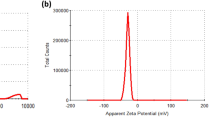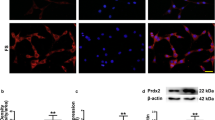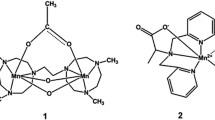Abstract
The objective of our study was to investigate the neuroprotective efficacy of superoxide dismutase (SOD), loaded in poly(d,l-lactide co-glycolide; PLGA) nanoparticles (NPs), in cultured human neurons challenged with hydrogen peroxide (H2O2)-induced oxidative stress. We hypothesized that the protected and sustained intracellular delivery of SOD encapsulated in NPs would demonstrate better neuroprotection from oxidative stress than either SOD or pegylated SOD (PEG-SOD) in solution. SOD-NPs (~81 ± 4 nm in diameter, 0.9% w/w SOD loading) released the encapsulated SOD in an active form with 8.2% cumulative release during the first 24 h, followed by a slower release thereafter. The results demonstrated that PLGA-NPs are compatible with human neurons, and the neuroprotective effect of SOD-NPs is dose-dependent, with efficacy seen at >100 U SOD, and less significant effects at lower doses. Neither SOD (25–200 U) nor PEG-SOD (100 U) in solution demonstrated the neuroprotective effect under similar conditions. The neuroprotective effect of SOD-NPs was seen up to 6 h after H2O2-induced oxidative stress, but the effect diminished thereafter. Confocal microscopic studies demonstrated better intracellular neuronal uptake of the encapsulated model protein (fluorescein isothiocyanate-labeled BSA) than the protein in solution. Thus, the mechanism of efficacy of SOD-NPs appears to be due to the stability of the encapsulated enzyme and its better neuronal uptake after encapsulation.


Similar content being viewed by others
References
Panyam, J., & Labhasetwar, V. (2003). Advanced Drug Delivery Reviews, 55, 329–347.
Wolburg, H., & Lippoldt, A. (2002). Vascular Pharmacology, 38, 323–337.
Sun, H., Dai, H., Shaik, N., & Elmquist, W. F. (2003). Advanced Drug Delivery Reviews, 55, 83–105.
Ellis-Behnke, R. G., Teather, L. A., Schneider, G. E., & So, K. F. (2007). Current Pharmaceutical Design, 13, 2519–2528.
Maier, C. M., & Chan, P. H. (2002). Neuroscientist, 8, 323–334.
Warner, D. S., Sheng, H., & Batinic-Haberle, I. (2004). Journal of Experimental Biology, 207, 3221–3231.
McCormick, M. L., Gavrila, D., & Weintraub, N. L. (2007). Arteriosclerosis, Thrombosis, and Vascular Biology, 27, 461–469.
Wassmann, S., Wassmann, K., & Nickenig, G. (2004). Hypertension, 44, 381–386.
Yasui, K., & Baba, A. (2006). Inflammation Research, 55, 359–363.
MacNee, W. (2005). European Respiratory Review, 14, 12–22.
Szeto, H. H. (2006). AAPS Journal, 8, E521–E531.
Tsubokawa, T., Jadhav, V., Solaroglu, I., Shiokawa, Y., Konishi, Y., & Zhang, J. H. (2007). Stroke, 38, 1057–1062.
Francis, J. W., Ren, J., Warren, L., Brown, R. H., & Finklestein, S. P. (1997). Experimental Neurology, 146, 435–443.
Yoshida, K., Burton, G. F., McKinney, J. S., Young, H., & Ellis, E. F. (1992). Stroke, 23, 865–869.
Brazil, M. (2002). Nature Reviews, Drug Discovery, 1, 10.
Vasir, J. K., & Labhasetwar, V. (2007). Advanced Drug Delivery Reviews, 59, 718–728.
Davda, J., & Labhasetwar, V. (2005). Journal of Biomedical Nanotechnology, 9, 74–82.
Sah, H. (1999). Journal of Controlled Release, 58, 143–151.
Prabha, S., Zhou, W. Z., Panyam, J., & Labhasetwar, V. (2002). International Journal of Pharmaceutics, 244, 105–115.
Miller, W. L., & Kester, D. R. (1988). Analytical Chemistry, 60, 2711–2715.
Donnan, G. A. (2007). Stroke, 39, 242–248.
Vessey, D. A., Lee, K. H., & Blacker, K. L. (1992). Journal of Investigative Dermatology, 99, 859–863.
De la Monte, S. M., Neely, T. R., Cannon, J., & Wands, J. R. (2000). Cellular and Molecular Life Sciences, 57, 1471–1481.
Conde de la Rosa, L., Schoemaker, M. H., Vrenken, T. E., Buist-Homan, M., Havinga, R., Jansen, P. L., et al. (2006). Journal of Hepatology, 44, 918–929.
Supinski, G. S., & Callahan, L. A. (2006). American Journal of Respiratory and Critical Care Medicine, 173, 1240–1247.
McKinney, J. S., Willoughby, K. A., Liang, S., & Ellis, E. F. (1996). Stroke, 27, 934–940.
Veronese, F. M., Caliceti, P., Schiavon, O., & Sergi, M. (2002). Advanced Drug Delivery Reviews, 54, 587–606.
Chi, L. G., Tamura, Y., Hoff, P. T., Macha, M., Gallagher, K. P., Schork, M. A., et al. (1989). Circulation Research, 64, 665–675.
Beckman, J. S., Minor Jr., R. L., White, C. W., Repine, J. E., Rosen, G. M., & Freeman, B. A. (1988). Journal of Biological Chemistry, 263, 6884–6892.
Truelove, D., Shuaib, A., Ijaz, S., Ishaqzay, R., & Kalra, J. (1994). Free Radical Biology & Medicine, 17, 445–450.
Whittemore, E. R., Loo, D. T., Watt, J. A., & Cotman, C. W. (1995). Neuroscience, 67, 921–932.
Huang, F., Vemuri, M. C., & Schneider, J. S. (2004). Brain Research, 997, 79–88.
Acknowledgment
Grant support from the Nebraska Research Initiative, the National Institutes of Health (MH67525-01), and Telomolecular, Inc., Rancho Cordova, CA, 95670, USA, is gratefully acknowledged. Authors thank Ms. Melissa Jedlicka for proof-reading the manuscript.
Conflict of Interest
M.K.R. and V.L. have financial interest in Telomolecular, Inc.
Author information
Authors and Affiliations
Corresponding author
Rights and permissions
About this article
Cite this article
Reddy, M.K., Wu, L., Kou, W. et al. Superoxide Dismutase-Loaded PLGA Nanoparticles Protect Cultured Human Neurons Under Oxidative Stress. Appl Biochem Biotechnol 151, 565–577 (2008). https://doi.org/10.1007/s12010-008-8232-1
Received:
Accepted:
Published:
Issue Date:
DOI: https://doi.org/10.1007/s12010-008-8232-1




